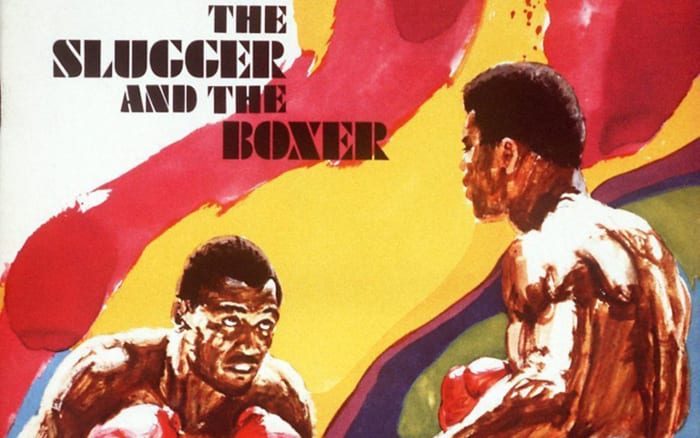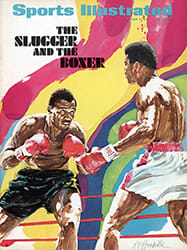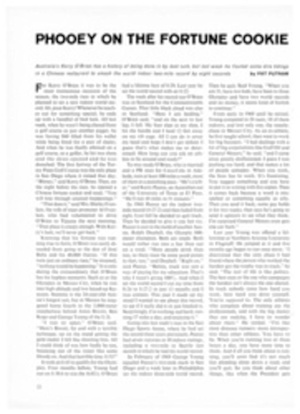The Boxer and the Slugger
The classic confrontation in prizefighting—the best of all possible matchmaking—is between a man who can hit and a man who is adept at not getting hit; in short, a fight between a puncher and a boxer. But the terms are not mutually exclusive. A boxer may well have a strong punch of his own; he simply waits for the precise moment to deliver it, meanwhile confounding his opponent with a variety of feints and draws, bobbing or weaving or fading away as the slugger strives to reach him. it is very much like a matador maneuvering a bull into position for the kill Except that sluggers are usually less suicidally inclined than bulls.
In any event, it makes for a most interesting match, and over the years the very best fights in the heavyweight division have always been between those boxers who could win on points and fighters who could win with one punch—boxer Jack Johnson vs. slugger Jess Willard, Gene Tunney vs. Jack Dempsey, Billy Conn vs. Joe Louis, Ezzard Charles vs. Rocky Marciano. In this selection the slugger won three out of four, lending credence to an old adage, "Always go with the banger."
But that may be just one more commonly accepted notion waiting to be destroyed by Muhammad Ali. He is a superb boxer for a heavyweight; perhaps, as he says, the greatest of them all. And he is a mighty good puncher, too. In Joe Frazier he meets the very model of the relentlessly oncoming slugger. The fight, on March 8 at Madison Square Garden, will surely rank with the classics depicted on the following pages.
WILLARD-JOHNSON
One of prizefighting's greatest debates has been whether Willard really did knock out Johnson in the 110° heat of Havana on the afternoon of April 5, 1915 or whether Johnson, as he "confessed" years later, took a $50,000 bribe to throw the fight. Now a rare film (from which the drawings on the opposite page were made) establishes that Willard scored a clean knockout with a devastating right It came in the 26th round. Johnson, the boxer, had dominated the bout until the 25th when Willard caught him with a blow to the pit of the stomach. Johnson's face contorted in agony. In the next round a Willard right to the head put Johnson down—knees drawn up to protect his legs from the hot canvas, he said years later, and his right arm "shading" his eyes. But the film shows clearly that there was no shadow on his eyes, and seconds later it records his legs collapsing to the canvas, hot or not. The verdict of history must be in Willard's favor.
DEMPSEY-TUNNEY
The Long Count—those 14 seconds are the most famous in boxing history. On Sept. 22, 1927, a year and a day after they had fought in Philadelphia, Jack Dempsey, now the challenger, and Gene Tunney, now the champion, met once more in Chicago before 104,943 fans. As before, Tunney was outboxing Dempsey; then, in the seventh round, the challenger caught the champion with a left-right combination and followed it with a barrage that left Tunney seated on his white trunks, one glove clutching the ropes (right). Before the bout both fighters had agreed to a new rule that the man scoring a knockdown must go immediately to the farthest neutral corner, whereupon the referee would start the count But that was not Dempsey's style. He went to the corner nearest the stricken Tunney, while Referee Dave Barry ordered him, at first without effect, to observe the rule. Dempsey finally obeyed and Barry began the count. An instant before he sounded 10 Tunney got to his feet, still shaky and apparently easy prey. But the champion then began a retreat (left, above) that Napoleon would have admired. Tunney weathered the round, floored Dempsey in the 10th (left) and won the decision.
LOUIS-CONN
He was such an outstanding boxer that some experts picked Billy Conn to be the next heavyweight champion when he was just a middleweight. On the night he met Joe Louis for the title, June 18, 1941, Conn still was only a light-heavy; at 174 pounds he was dwarfed by Louis' 199½. But the prophecy almost came true. After two inconclusive rounds the boyish-looking challenger began to dominate the mature champion. Conn's flurries piled up points, and his evasive tactics confused the plodding Louis. Billy was hitting (above) when he wanted to, retreating when he had to. Until the 11th round, that is, when he decided, against the advice of his corner, to take on the bigger man in a slugging match. It was an absurd notion, but for a time it actually paid off, perhaps because Louis was surprised. Conn won the 11th. Even so, his corner again urged caution. Conn shrugged off the advice. He won the 12th, too, banging away with good left hooks. But in the 13th the inevitable occurred; Louis caught Conn with a right and followed it with an onslaught (opposite) that ended only when Billy went down—and out.
MARCIANO-CHARLES
Rocky Marciano had not an ounce of subtlety in his squat body. What he had was power. He pounded his opponents to the canvas by brute strength and ceaseless aggression, along with a certain disregard for the rules of gentlemanly jousting. He took a dozen punches all but heedlessly to get past another fighter's guard in order to deliver one battering, short-armed blow of his own—or more than one, depending on how many were necessary. But, oddly enough, the first time he met Ezzard Charles—a good sound boxer—he won in 15 rounds, by decision. No other fighter had gone more than 13 with Marciano. Had Rocky won by outboxing a boxer? Not really. He had outslugged a boxer over the full distance. They met again, three months later, on Sept. 17, 1954, and this time it was different. Rocky lost the first round, some said, and that was all. He knocked Charles down in the second and, though his nose was split in the sixth round (right), he was in command the rest of the way. The end came in the eighth, when Charles went down for a three-count from a long right, then succumbed to a clean knockout from a left hook and a right cross. After two more fights Rocky retired, never beaten.
ALI-FRAZIER
Now comes Muhammad Ali, superb boxer, to challenge slugger Joe Frazier Both were Olympic champions; neither has known defeat as a professional. Ali has knocked out 25 of 31 opponents; Frazier has knocked out 23 of 26. What separates them is their unique styles. Ali is the very epitome of a clever heavyweight. The old movies establish that he is superior in this regard to Johnson or Tunney. And he can punch, as his record proves But he never has met a man like Frazier whose style reminds one—at least superficially—of Marciano's and whose punch may be just as devastating, though these considerations never can be measured with accuracy. The nimble Ali, with his uncanny ability to stay just out of range of an opponent's punches—especially those aimed at his face—and the slogging, deadly earnest Frazier are today's premier exponents of the two basic styles involved in the ring. Ali's long left opposes the crouching, charging Frazier attack: the body blows of Frazier against the head punching of Ali. And finally there is the supreme test of the coolness under pressure of both men. On this score, Frazier never has been questioned. Ali, on occasion, notably in his match with the classic Englishman, Henry Cooper—who put him down—has needed steadying from his corner.
EIGHTEEN
ILLUSTRATIONS
ROBERT
HANDVILLE
FOUR ILLUSTRATIONS


